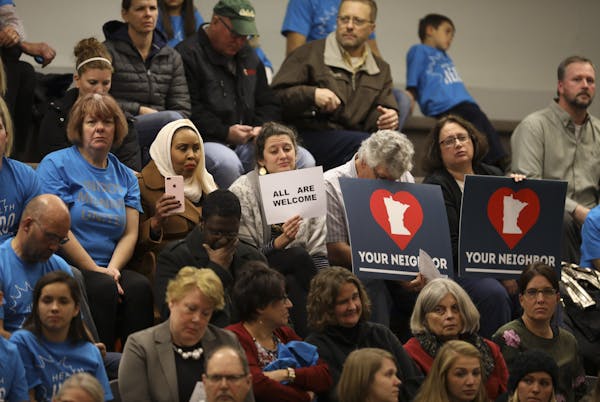Heated rhetoric gave way to hard data in St. Cloud on Tuesday, where numbers released to Stearns County commissioners showed that refugee resettlement in the area has had little to no impact on the county's budget.
The data, delivered amid growing scrutiny and debate in recent months over resettlement costs in the St. Cloud area, showed that while the number of primary refugees — those whose first home in the U.S. is in Stearns County — grew to a record 281 people in 2016, refugee resettlement has had almost no effect on the county's budget.
"There are very few taxpayer dollars used to support refugee resettlement," Melissa Huberty, the county's human services administrator, said afterward. "We're looking to make sure the facts get out there. There's a lot of misinformation in the community."
Across Minnesota, more than $180 million in state and federal dollars were spent in 2015 on cash, food and medical assistance for refugees, according to data the state compiled for the Star Tribune this year. That's up 15 percent from five years ago, but is still less than 2 percent of total expenses for these programs.
No city or county funds are budgeted directly for resettlement. Rather, Stearns County administers state and federal funding for the work.
Still, the issue has created some hot debate in St. Cloud, a city of 66,000 residents in central Minnesota with a growing refugee population — most of which is from Somalia.
Anti-Muslim events there have drawn crowds in recent months, mirroring rising anti-Muslim sentiment nationally.
Some residents also have called for the city to impose controls on resettlement. Earlier this month, St. Cloud Council Member Jeff Johnson proposed a resolution recommending a moratorium on resettlement until the city gets details on the cost of the federal program on taxpayers. His measure failed.
Instead, the council approved 6-1 a resolution affirming that it is a "welcoming community."
According to data (online at bit.ly/2jtLDav) presented to county commissioners, in December 2016, 76 refugees received federally funded refugee cash assistance in Stearns County totaling $14,752. That's the only benefit specifically for refugees in the U.S., and is limited to up to eight months. That accounts for 0.1 percent of all county benefit disbursements.
The county spends money on interpreter services — $240,663 in 2016 — and public health services to refugees — $57,000 in 2016. The cost for both has gone down in 2017, Huberty said.
Lutheran Social Service of Minnesota, the only organization that oversees refugee resettlement in St. Cloud, has helped move an average of 189 refugees a year to the area since 2010 and expects to resettle another 225 refugees in 2018.
In the organization's first public webinar Tuesday, officials said refugees get a one-time federal grant of $1,125 that must be used within 90 days of arriving. All refugees also pay local and state taxes. In 2014, that totaled $227.2 million in state and local revenue in Minnesota, according to the state Department of Human Services.
Data on refugees is limited because a refugee is just one type of immigrant status. Secondary refugees who moved to St. Cloud from another U.S. city aren't tracked, Huberty said.
"People can get to move around and choose where to live just like any other resident," she said after the 80-minute webinar, attended by more than 100 people. "Refugees pay taxes; they participate in the community in a really large way. They're a very valuable resource and great contributors in the community."
Kelly Smith • 612-673-4141
Searching for Snoopy: What happened to all the 'Peanuts' statues in St. Paul?
North Oaks withdraws request for density exemption from Met Council

Fall or spring, it's Rochester Mayo's year in prep tennis

Minneapolis reaches $150k settlement with eyewitness of George Floyd's murder

